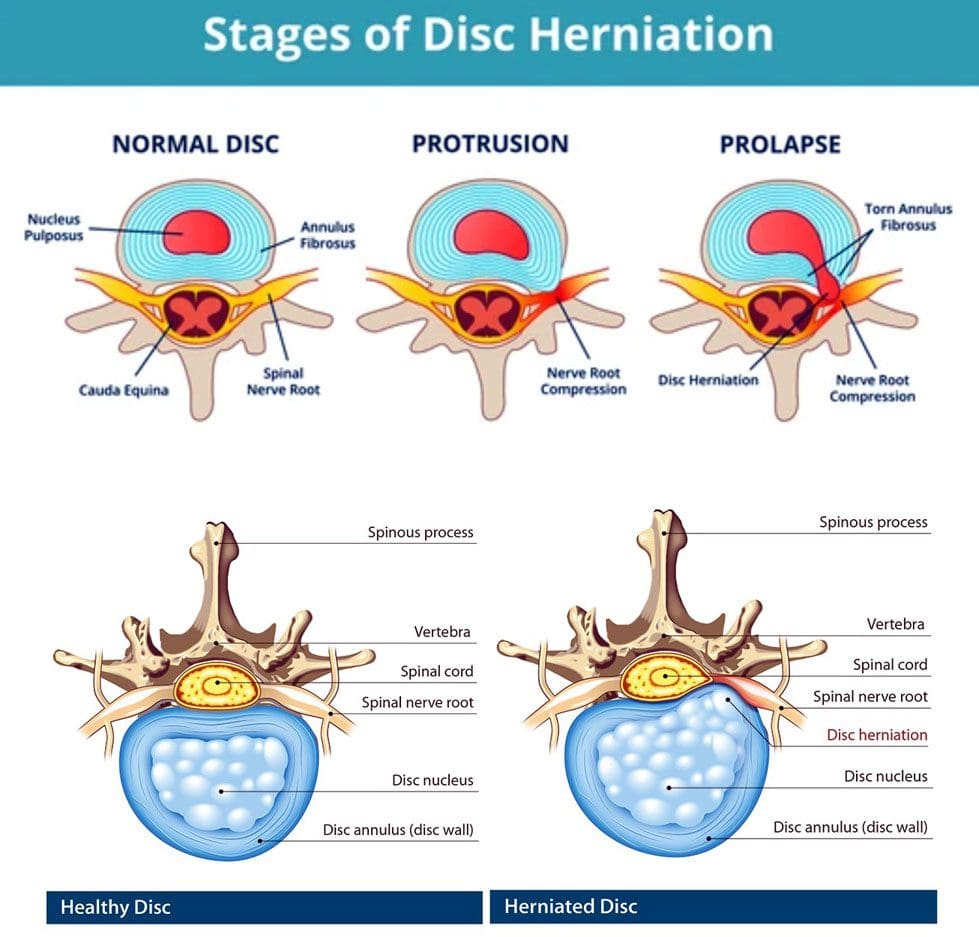Spinal disc deterioration from aging is normal, but health issues or injuries can advance the degenerative process. Disc protrusions are related to herniated discs but are the mildest form of the condition and are a common form of spinal disc deterioration that can cause neck and back issues. However, individuals may have a small protruding disc that can go undetected unless it irritates or compresses the surrounding nerves. Chiropractic care, decompression, and massage therapy can realign the disc back into position, relieving discomfort and pain.

Disc Protrusion
A disc is like a sturdy soft rubber shock absorber/cushion with added gel inside. The gel acts as a shock absorber. When the gel begins to protrude out slightly, this is a disc protrusion. Once a protruding disc begins to develop, it usually remains in that position. The disc can sometimes reabsorb on its own and realign back into position, but there is no way of knowing that will happen or how long it will take. With age and/or injuries, the body's parts change. The spine's discs dehydrate and lose elasticity weakening the discs and making them more vulnerable to herniation stages:
First Stage
- Following natural weakening can be classified as a disc protrusion when the disc's core begins pushing into the spinal column.
- Disc protrusions can be tiny or push out an entire side of the disc.
Second Stage
- Disc deterioration often consists of a bulging disc when the core pushes out farther around the circumference beyond the disc's outer layer, called the annulus fibrosus, creating the telltale bulge.
- A bulging disc involves more than 180 degrees of the disc's circumference.
Third Stage
- The third stage is a herniated disc, meaning the disc's outer wall has torn, allowing the inner gel to leak out, usually irritating the surrounding nerves.
Fourth Stage
- The fourth stage is sequestration, a herniated disc in which a piece of the nucleus breaks free of the vertebral disc fragments and falls into the spinal canal.
Types
A disc protrusion is one type of disc herniation that pushes out but remains connected. Different types compress and irritate the discs differently and produce various symptoms, including:
Paracentral
- This is the most common, where the disc protrusion jams the space between the central canal and the foramen.
Central
- This is where the disc protrusion impinges into the spinal canal, with or without spinal cord compression.
Foraminal
- The disc intrudes into the foramen, the space through which nerve roots branch off the spinal cord and exit the vertebrae.
Symptoms, Diagnosis, and Chiropractic Care
Individuals with a disc protrusion can have symptoms similar to sciatica, which includes back, buttock, and leg discomfort, numbness, and pain sensations.
- Treatment for disc protrusion will be based on the individual's symptoms.
- A chiropractor will take a detailed medical history and perform a physical examination.
- A spinal MRI test could be ordered depending on the injury or condition.
- A customized treatment plan will be developed to fit the individual's medical needs.
Most disc protrusions improve after a few weeks of rest, avoiding strenuous activities, activity modification, an anti-inflammatory diet, and gentle exercises that the chiropractic team will provide.
True Spinal Decompression
The information herein is not intended to replace a one-on-one relationship with a qualified healthcare professional or licensed physician and is not medical advice. We encourage you to make your own healthcare decisions based on your research and partnership with a qualified healthcare professional. Our information scope is limited to chiropractic, musculoskeletal, physical medicines, wellness, sensitive health issues, functional medicine articles, topics, and discussions. We provide and present clinical collaboration with specialists from a wide array of disciplines. Each specialist is governed by their professional scope of practice and their jurisdiction of licensure. We use functional health & wellness protocols to treat and support care for the injuries or disorders of the musculoskeletal system. Our videos, posts, topics, subjects, and insights cover clinical matters, issues, and topics that relate to and directly or indirectly support our clinical scope of practice.* Our office has reasonably attempted to provide supportive citations and identified the relevant research study or studies supporting our posts. We provide copies of supporting research studies available to regulatory boards and the public upon request.
We understand that we cover matters that require an additional explanation of how it may assist in a particular care plan or treatment protocol; therefore, to further discuss the subject matter above, please feel free to ask Dr. Alex Jimenez or contact us at 915-850-0900.
Dr. Alex Jimenez DC, MSACP, CCST, IFMCP*, CIFM*, ATN*
email: coach@elpasofunctionalmedicine.com
Licensed in: Texas & New Mexico*
References
Fardon, David F et al. "Lumbar disc nomenclature: version 2.0: Recommendations of the combined task forces of the North American Spine Society, the American Society of Spine Radiology and the American Society of Neuroradiology." The spine journal: official journal of the North American Spine Society vol. 14,11 (2014): 2525-45. doi:10.1016/j.spinee.2014.04.022
Mysliwiec, Lawrence Walter, et al. "MSU classification for herniated lumbar discs on MRI: toward developing objective criteria for surgical selection." The European spine journal: official publication of the European Spine Society, the European Spinal Deformity Society, and the European Section of the Cervical Spine Research Society vol. 19,7 (2010): 1087-93. doi:10.1007/s00586-009-1274-4
https://www.ninds.nih.gov/low-back-pain-fact-sheet#3102_7
Urban, Jill P G, and Sally Roberts. "Degeneration of the intervertebral disc." Arthritis research & therapy vol. 5,3 (2003): 120-30. doi:10.1186/ar629




